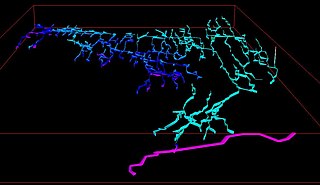Fox maze
| Fox maze
|
||
|---|---|---|
|
3D partial view |
||
| Location: | near Schmalfelden , Baden-Württemberg , Germany | |
| Height : | 476 m | |
|
Geographic location: |
49 ° 19 '47 " N , 10 ° 1' 40" E | |
|
|
||
| Cadastral number: | 6626/3 | |
| Geology: | Upper Muschelkalk | |
| Discovery: | 1974 | |
| Show cave since: | No | |
| Overall length: | 14 km | |
| Level difference: | 20 m | |
The fox Labyrinth belongs at 14 km Total length of the five longest caves in Germany. The cave is located near Schrozberg - Schmalfelden in Baden-Württemberg and was discovered in a quarry in 1974 by the Arbeitsgemeinschaft Höhle und Karst Stuttgart . The name reminds us that the cave was inhabited by foxes at that time.
The cave is located in a bulge of the Upper Muschelkalk of the Hohenlohe Plain .
The cave system consists of two parts: The upper, dry part consists of narrow north-south fissures of different heights. These are connected by very low tubes or layer joints running from west to east. In 1988 a waterway was discovered under this labyrinth, which extends several kilometers from west to east and ends in both directions at siphons that have not yet been submerged. This waterway is hydrologically connected to the Schandtauberhöhle .
Publications about this object can be found among others. a. in the articles on cave and karst studies in southwest Germany .
The cave is not open to the public.
Individual evidence
- ^ ARGE Höhle und Karst Stuttgart. Retrieved May 7, 2018 .
- ↑ Fox labyrinth. ARGE Höhle und Karst Stuttgart eV, accessed on March 30, 2019 .
- ↑ Articles on cave and karst science in southwest Germany, issues 50, 51 and 56. ARGE Höhle und Karst Stuttgart eV, accessed on May 6, 2020 .
literature
- Lukas Plan, Eva Kaminsky: Something completely different: A tour of the fox labyrinth and comments on its creation Höhlenkundliche Mitteilungen, 76th year, Vienna 2020, ISSN 2307-003X, pp. 58–63.
- Andreas Hoydem, Markus Pantle, Thomas Rathgeber & Theo Simon: Speleogenesis of the fox labyrinth Laichinger Höhlenfreund, 53rd year, Laichingen 2018, ISSN 0344-6832, pp. 15 - 40. Ed .: Höhlen- und Heimatverein Laichingen eV
- Michael Ross: The fox labyrinth - a curious cave in the Upper Muschelkalk in southwest Germany. Die Höhle, 67th year, Vienna 2016, ISSN 0018-3091, pp. 97–111.
- Michael Ross: The Fuchslabyrinth Maze - a speleogenetic obstacle? Eurospeleo 2016 sessions. Retrieved August 29, 2016.
- Martin Trappe, Rebecca Engelhardt: Clastic sediments from the fox labyrinth near Schmalfelden - Contributions to the genesis of a complex cave system. Laichinger Höhlenfreund, 50th year, Laichingen 2015, ISSN 0344-6832, pp. 99–118.
- Michael Wasmund: resumption of research in the fox labyrinth (cat.-no. 6626/3) in Schmalfelden (town of Schrozberg, district of Schwäbisch Hall). Contributions to cave and karst studies in southwest Germany, No. 51, Stuttgart 2015, ISSN 2509-8993, pp. 37–48.
- Michael Wasmund: The beginning of a "never-ending" story - the discovery of the fox labyrinth (cat. No. 6626/3) in November 1974. Contributions to cave and karst studies in southwest Germany, No. 50, Stuttgart 2012, ISSN 2509-8993, Pp. 5-8.
- Markus Pantle: Discovery and recovery of ceramic finds in the fox labyrinth (cat. No. 6626/3) in 1989 and 1994. Contributions to cave and karst studies in southwest Germany, no. 50, Stuttgart 2012, ISSN 2509-8993, p. 9-16.
- Robert Winkler: The underground experiment - the beginning of a long tradition. Grabenstettener Höhlenkundliche Hefte, annual booklet 2009, Grabenstetten 2010, pp. 132-134.
- Benjamin Menne: Some findings on the colonization of sediments in the fox labyrinth (6626 / 3A) by microorganisms of the order Myxobacterales, notifications from the Association of German Cave and Karst Researchers, Volume 45, Munich 1999, ISSN 0505-2211, pp. 89-91.
- Ralph Müller, Martin Nething et al. a .: Via the fox labyrinth and the neighboring crevasse caves near Schmalfelden (municipality of Schrozberg, district of Schwäbisch Hall). Contributions to cave and karst studies in southwest Germany, No. 37, Stuttgart 1994, ISSN 2509-8993, pp. 3-19.

